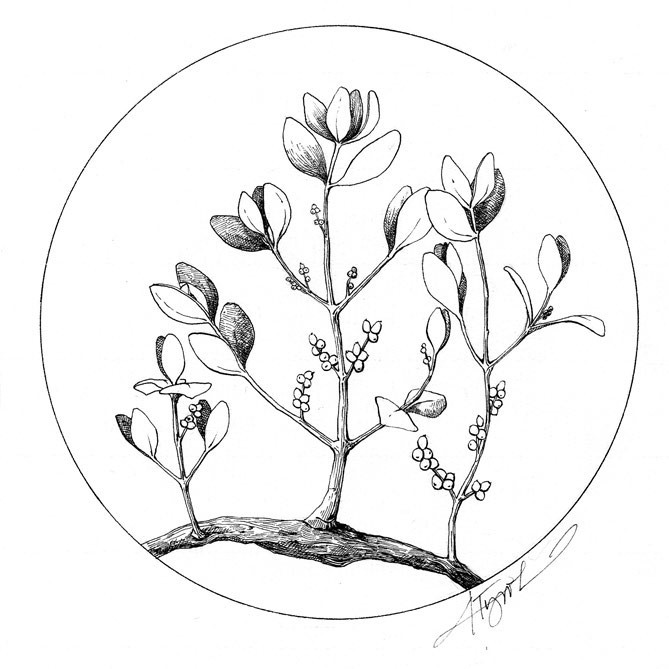
The winter holidays are a wonderful time to learn about nature. After all, is there another time of year when we kiss under a parasitic plant? Or sing about decorating our halls with spiny-leafed, red-berried tree branches? Or enjoy red flowers that actually aren’t flowers? Christmas is a time when nature pays a visit in the form of some traditional but unusual plants.
At Christmas, it’s usually the trees and wreaths that get top billing. But mistletoe, holly and poinsettias are popular as well. Unlike our native evergreens these exotic Christmas plants usually travel great distances to reach our homes.
More than 1,300 species of mistletoe grow around the world, but the kind under which we kiss – the mistletoe with leathery leaves; tiny white flowers, and small, white waxy berries—is one of the plainest. Two similar-looking, species of mistletoe are used at Christmas. One grows on the East Coast of the United States – ranging only as far north and east as New York – and the other grows throughout the British Isles and much of the rest of Northern Europe. (In Great Britain, largely because of high demand at Christmas, mistletoe is becoming harder to find.)
Mistletoe is a parasitic plant. It lives off nutrients from other plants, usually after wedging a root into the other plant’s circulatory system. Mistletoe grows on many types of trees. In ancient times in Europe it was considered an especially potent promoter of romance when it grew on an oak tree.
In Western forests a mistletoe called “dwarf mistletoe” grows in Douglas-firs and other evergreens and has an unusual characteristic: The plant can shoot seeds up to 50 feet at speeds of up to 60 miles an hour. Water pressure in the fruit builds up, and when released, it powers the seed’s explosive journey. The seeds are sticky, and if they hit another tree, they are likely to stay put until they germinate and infect the tree.
Like mistletoe, the species of holly that we use at Christmas—“American holly”—is native to the East Coast but not to Northern New England.
We do find it growing in New Hampshire and Vermont, but almost always in the form of landscape trees, which can grow up to 50 feet tall. Our swamps do have one species of holly – mountain holly – but it is only about half as tall, and it has smooth-edged leaves, rather than spiny ones.
Poinsettia, which enters our homes as a potted plant, is a shrub that is native to the mountains of Mexico and Central America. In the wild the plant can grow 6 feet wide and 10 feet tall. In their natural state, poinsettias don’t survive easily outside of their hot, dry desert environment.
Poinsettias became a symbol of Christmas in North America early in the last century, when a California grower, Paul Ecke, created a cultivar that was houseplant-sized, lush and tough enough to survive shipping to colder climates. Promoting the plant through flower shows and women’s magazines, the Ecke family created a new holiday tradition. Poinsettias are now grown across the country and available practically everywhere.
What some find surprising about the poinsettia is that its red part is not a flower petal but rather a modified leaf, known as a bract. They are the same size and shape as leaves, only they are red, not green. (These bracts have traces of chlorophyll, so they photosynthesize.) The poinsettia’s colorful bracts attract the attention of pollinators, which are apt to visit the plant’s tiny yellow flowers that are clustered in the center of the bracts.
I’m not sure which is more amazing, that this bush from Mexico has become an indispensable Christmas decoration in the U.S., or that it has brought the technical botanical term “bract” into the vocabulary of flower enthusiasts.
One thing is certain: Those vivid crimson bracts offer welcome touches of color when our landscape is at its snowy whitest or gloomy grayest.


Discussion *